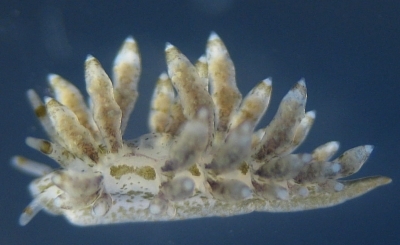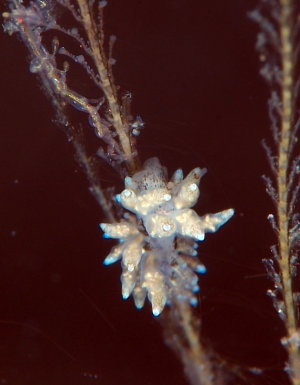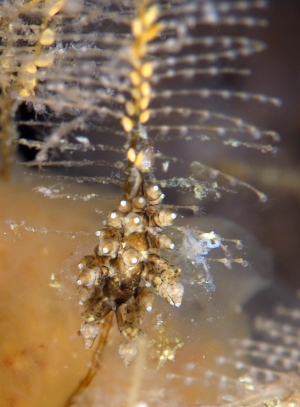
Eubranchus rustyus
(Marcus, 1961)
Order: NUDIBRANCHIA
Superfamily: AEOLIDINA
Family: Eubranchidae
DISTRIBUTION
Vancouver Is, British Columbia to Punta Abreojos, Baja California, Mexico
PHOTO
Locality: Scott Creek, Santa Cruz County, Intertidal, California, USA, NE Pacific, 12 June 2006, Rocky shore. Length: 7mm. Photographer: Jeff Goddard.
Marcus (1961) described this species from preserved specimens and gives the following very brief description of the living colour from collector's notes: "The living animals were white to translucent with pink cerata". Behrens (1980) describes the animal as "white with small yellow-white dots. Rhinophores, cerata, and oral tentacles are tipped with white and all three have subterminal bands of brown to green. the inflated cerata have tubercles in 2 or 3 bands and their cores are green to brown. Often occurring in dense localized blooms on the hydroids Obelia and Plumularia. To 25 mm".
Also from Jeff Goddard's message [#17539]
" Compared to the sympatric E. rupium (= E. olivaceus), this species lacks flecks of red-brown and opaque white on the body, and instead has irregular blotches and flecks of olive green on both the body and foot. Also, the digestive gland ducts are plainly visible through the body wall of E. rupium, but not in E. rustyus. Eubranchus rustyus feeds on species of Plumularia and also lacks the tentaculate foot corners of E. misakiensis."
-
Behrens, D.W. (1980) Pacific Coast Nudibranchs. A guide to the Opisthobranchs of the Northeastern Pacific. Sea Challengers. Los Osos, California. 112 pp.
-
Marcus, Er. (1961) Opisthobranch mollusks from California. Veliger, 3 (suppl): 1-85.
Rudman, W.B., 2003 (July 31) Eubranchus rustyus (Marcus, 1961). [In] Sea Slug Forum. Australian Museum, Sydney. Available from http://www.seaslugforum.net/find/eubrrust
Related messages
Eubranchus rustyus from British Columbia
September 12, 2007
From: Clinton Bauder

Hi Bill,
Part one of three for various Eubranchus animals I found in British Columbia. I saw literally hundreds of similar looking animals but after spending some time looking at the images I'm having trouble sorting them into rustyus, olivaceus/rupium and misakiensis.
I think this animal might be E. rustyus. The coloration is more green than red and it doesn't have the white specs on it.
Locality: Hussar Point, 20 meters, British Columbia, Canada, Pacific, 26 August 2007, Rock Wall. Length: 4 mm. Photographer: Clinton Bauder.
Clinton Bauder
gecko1@apple.com


Hi Clinton,
Eubranchus rustyus can be difficult to ID, but that is what you have here. Patches on the body and the shape and color of the cerata give it away. E. misakiensis is the closest to this species but it has large oval brown spots on the body.
Thanks,
Dave Behrens
Eubranchus rustyus [2] from California
July 27, 2007
From: Clinton Bauder

Hi Bill,
Also found this animal which I also believe to be Eubranchus rustyus. They are slightly different from the other example in that the distal end of the cerata seem to have a red tip on them rather than white. These shots also show the egg mass.
These animals were about the same size as my other example and on the same kind of hydroid and were within a few meters of the first on the reef.
Locality: Pfieffer Point, 20 meters, CA, USA, Pacific, 21 July 2007, Rocky Reef. Length: 3 mm. Photographer: Clinton Bauder.
Clinton Bauder
gecko1@apple.com



Hi Clinton,
I agree again. I think what we are seeing here is simply variation. Great to have the eggs.
Again, thanks for sharing,
Dave Behrens
==================
In a recent message [#19058] I mentioned how caprellid amphipods can displace aeolids from hydoid colonies. I am not sure what the photo alongside indicates but I thought it worth mentioning that the whole 'branch' on the left of the photo is covered in caprellids.
Bill Rudman
Behrens, D.W., 2007 (Jul 27). Comment on Eubranchus rustyus [2] from California by Clinton Bauder. [Message in] Sea Slug Forum. Australian Museum, Sydney. Available from http://www.seaslugforum.net/find/20296Eubranchus rustyus from California [1]
July 27, 2007
From: Clinton Bauder

Hi Bill,
This is Eubranchus rustyus. Alicia had shown me this slug when she was here in May but it was too surgy to photograph it. It was still probably too surgy on Saturday but I gave it a go anyway, somewhat to the frustration of my dive buddies who spent the better part of the dive watching me shake my head and curse the camera.
Locality: Pfieffer Point, 20 meters, CA, USA, Pacific, 21 July 2007, Rocky Reef. Length: 3 mm. Photographer: Clinton Bauder.
Clinton Bauder
gecko1@apple.com



Hi Clinton,
Yes - your ID is correct. This tiny aeolid has green sploches on it back. Not bad shots considering the surge.
Thanks for sharing,
Dave Behrens
Eubranchus rustyus from central California
August 31, 2006
From: Jeff Goddard

Hi Bill,
Here is an image of a typical Eubranchus rustyus from the northeast Pacific Ocean. Compared to the sympatric E. rupium (= E. olivaceus), this species lacks flecks of red-brown and opaque white on the body, and instead has irregular blotches and flecks of olive green on both the body and foot. Also, the digestive gland ducts are plainly visible through the body wall of E. rupium, but not in E. rustyus. Eubranchus rustyus feeds on species of Plumularia and also lacks the tentaculate foot corners of E. misakiensis.
Locality: Scott Creek, Santa Cruz County, Intertidal, California, USA, NE Pacific, 12 June 2006, Rocky shore. Length: 7mm. Photographer: Jeff Goddard.
Best wishes,
Jeff
goddard@lifesci.ucsb.edu
Goddard, J.H.R., 2006 (Aug 31) Eubranchus rustyus from central California. [Message in] Sea Slug Forum. Australian Museum, Sydney. Available from http://www.seaslugforum.net/find/17539
Hi Jeff,
Nice coincidence you submit this at this time. Yes, perfect example. And thanks for the clear differentiations.
We are having a population explosion of this species up in Washington [Pacific coast, USA]. In Gig Harbor, in the south end of Puget Sound, the species can be found on Obelia.
Thanks,
Dave Behrens
Eubranchus sp. from British Columbia
January 25, 2006
From: Marli Wakeling

Hi Bill,
May is the time of year again in B.C. when the Eubranchus that confuses everyone is abundant.
Locality: Plumper Rock, Broughton Archipelago, British Columbia, Canada
Pacific. Depth: 45 feet. Length: 5 mm. 21 May 2005. Rocky wall. Photographer: Marli Wakeling
This time I have a much sharper photo, and it is the same animal that Paul Sim sent in in 2003 [#11225], and he wondered if it was E. rustyus. It is the same animal that inspired the E. misakiensis debate (and we don't wish to go down that road again!) It really doesn't match the description in Behrens very well, with its yellow spots and brown markings on the body. Can anyone really confirm that it is E. rustyus, or could it be something else? It's really common around BC every spring: I can't imagine it hasn't been described.
Cheers,
Marli Wakeling
scubamarli@excite.com
Wakeling, M., 2006 (Jan 25) Eubranchus sp. from British Columbia. [Message in] Sea Slug Forum. Australian Museum, Sydney. Available from http://www.seaslugforum.net/find/13924Dear Marli,
Well, you test us again. I wish this species was easier to identify from photos, but it simply isn't. We need to look at this guy under a dissecting microscope. If I had to roll the dice based on your improved photo here, I would have to go with Eubranchus rustyus.
Best wishes,
Dave Behrens
Eubranchus rustyus? from British Columbia
October 20, 2003
From: Paul Sim

Hi Bill
I have this one out for help with the local identification community here in Vancouver, but have not heard back so far. I have chosen to name it Eubranchus rustyus as much for its similar general appearance but with no real conviction that it is indeed the animal as described in David Behrens book. Have you any ideas Bill?
Location = Luca Channel, Port Hardy, BC, Canada
Terrain = rocky wall
Depth = 50 feet
Temp = 50 degrees farenheit
Equipment = Nikonos-V, 1:1, Fuji Reala
Paul Sim
plsim@shaw.ca
Sim, P., 2003 (Oct 20) Eubranchus rustyus? from British Columbia. [Message in] Sea Slug Forum. Australian Museum, Sydney. Available from http://www.seaslugforum.net/find/11225
Dear Paul,
I guess this could be the same, though if you look carefully it has small brown spots on the body. I've included a shot here showing the hydroid it is on. Perhaps someone can identify it for us because I suspect in the long run the hydroid species the nudibranchs feed on will be a useful way of separating these species
Best wishes
Bill Rudman
Eubranchus rustyus from Channel Ids, California
August 8, 2003
From: Bruce Wight


Dear Bill,
Johanna and I saw lots of great natural behavior on last weekends dive trip out to San Miguel Island [Channel Islands National Park, California - July 2003]. The ocean was flat and calm but the water was a cool 53 degrees F at depth. Here is one of a series of messages showing some images I took during the two day trip.
This is a shot of some tiny (most less than 1/8 inch in length) nudibranchs, that with their eggs, were all over some of the hydroid colonies. There are at least three of them in this image and several clusters of eggs. Dave Behren's has identified them for me as Eubranchus rustyus.
Best wishes,
Bruce Wight
bwproductions@earthlink.net
Wight, B., 2003 (Aug 8) Eubranchus rustyus from Channel Ids, California. [Message in] Sea Slug Forum. Australian Museum, Sydney. Available from http://www.seaslugforum.net/find/10653Thanks Bruce,
Another 'new animal' for the Forum
Best wishes,
Bill Rudman
